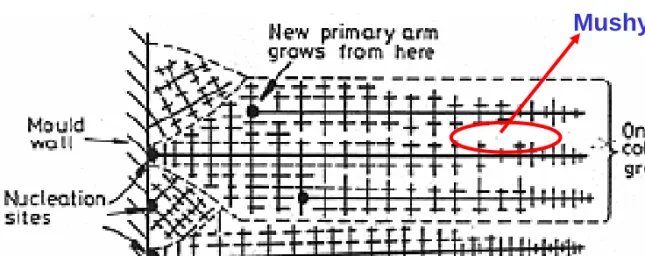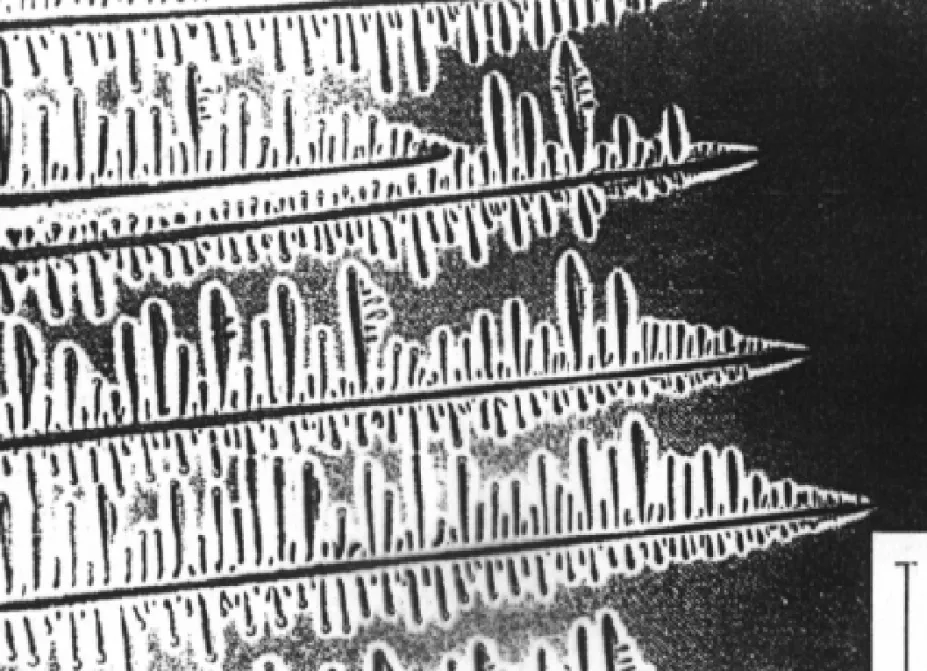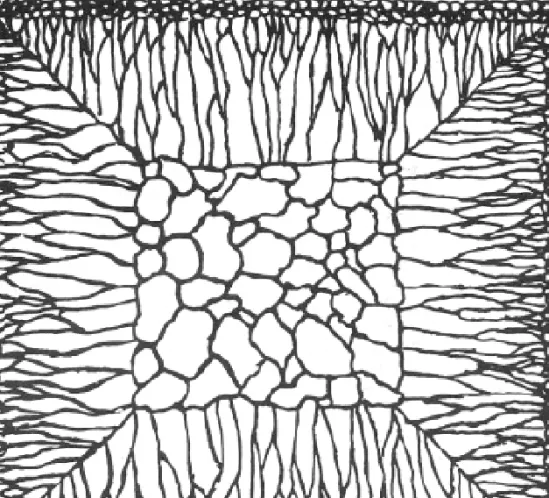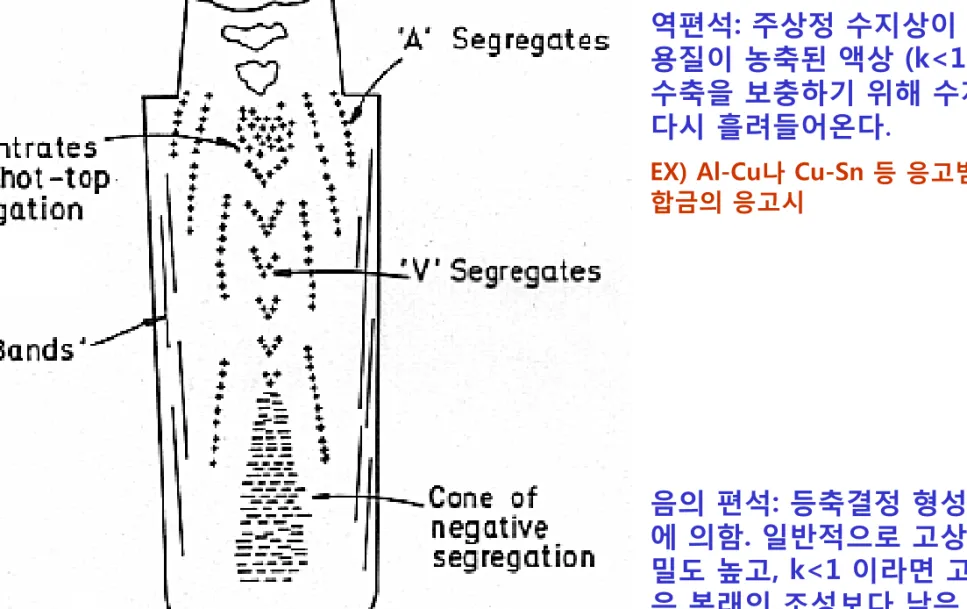1 1
Phase Transformation of Materials Phase Transformation of Materials
Eun Eun Soo Soo Park Park
Office: 33-316
Telephone: 880-7221 Email: espark@snu.ac.kr
Office hours: by an appointment
2009 fall
11. 24. 2009
2
“Alloy solidification”
Contents for previous class
2) Eutectic Solidification
< Thermodynamic > < Kinetic >
*
0
2 T
EV
mH T
1) Solidification of single phase alloys
TL ' /v < (T1 -T3 )/D Constitutional supercooling
TL’ ↓→ cellular solidification→ dendritic solidification
1) λ ↓→ 성장속도 ↑ 2) λ ↓→ γαβ↑로 계의 계면 E↑ 최소 λ 존재
GG
3 phse equilibrium, ΔG=0
공정의 성장속도
v
→ 성장 확산 제어→ α/L와 β/L 계면의 이동도가 커서 액상을 통한 용질이동과 비례
) 1
(
* 0
2
T D k v
2
*
Maximum v
D r
0 T T
T
2 4 0 0
3 2
0 0
)
( k
T v
k v
계면 곡률효과 + 극복 과냉도
확산 위한 충분한 조 성차주기 위한 과냉
total r D
G G G
3
4.3 Alloy solidification
- Solidification of single-phase alloys - Eutectic solidification
- Off-eutectic alloys
- Peritectic solidification
4.4 Solidification of ingots and castings
- Ingot structure
- Segregation in ingot and castings - Continuous casting
Contents for today’s class
4.6 Solidification during quenching from the melt
4
primary + eutectic lamellar
4.3.3 Off-eutectic Solidification
- Primary α dendrites form at T1 .
Rejected solute increases XL to XE ; eutectic solidification follows.
- Coring : primary α (low solute) at T1 and the eutectic (high solute) at TE .
→ in-situ composite materials
→ The alloy solidifies as 100%
‘eutectic’ with an overall composition X0 instead of XE .
5
6
7
4.3.4 Peritectic Solidification
- L + α → β , difficult to complete.
- α dendrites first form at T1 ;
Liquid reaches the composition ‘c’;
β forms as the result of the peritectic reaction;
α coring is isolated from further reaction finally β + γ eutectic forms.
8
Solidification and microstructure
that develop as a result of the
peritectic reaction
9
4.4 Solidification of Ingots and Castings
Ingot Structure - Chill zone
- Columnar zone - Equiaxed zone
Chill zone
- Solid nuclei form on the mould wall and begin to grow into the liquid.
- As the mould wall warms up it is possible for many of these solidified crystals to break away from the wall under the influence of the turbulent melt
.
주조된 제품이 최종 모양 을 유지하거나 혹은 기계 가공에 의해 최종 모양으 로 된 것
주조 후 압연, 압출 또는 단조 등에 의해 가공할 것 >> blank (작은 것)
10
Fig. 4.41 Competitive growth soon after pouring. Dendrites with primary arms
normal to the mould wall, i.e. parallel to the maximum temperature gradient, outgrow less favorably oriented neighbors.
Fig. 4.42 Favorably oriented dendrites develop into columnar grains. Each
columnar grain originates from the same heterogeneous nucleation site, but can contain many primary dendrite arms.
Columnar zone
After pouring the temperature gradient at the mould walls decreases and the crystals in the chill zone grow
dendritically in certain crystallographic directions, e.g.
<100> in the case of cubic metals.
Mushy zone
Fig. 4.28 Columnar dendrites in a transparent organic alloy. 11 (After K.A. Jackson in Solidification, American Society for Metals, 1971, p. 121.) 1차 가지 성장 방향 변화 열전도 방향 → 결정학적 우선 방향
12
Equiaxed zone
The equiaxed zone consists of equiaxed grains randomly oriented in the centre of the ingot. An important origin of these grains is thought to be melted-off dendrite side-arms. + convection current
Fig. 4.40 Schematic cast grain structure.
(After M.C. Flemings, Solidification Processing, McGraw-Hill, New York, 1974.)
13
14
Shrinkage effect
15
4.4.2 Segregation in Ingots and Castings
-
Macrosegregation
:Composition changes over distances comparable to the size of the specimen.
-
Microsegregation
:Occur on the scale of the secondary dendrite arm spacing.
Four important factors
that can lead tomacrosegregation
- Shrinkage due to solidification and thermal contraction.
- Density differences in the interdendritic liquid.
- Density differences between the solid and liquid
- Convection currents driven by temperature-induced density differences in the liquid.
16
Fig. 4.43 Segregation pattern in a large killed steel ingot. + positive, - negative segregation. (After M.C. Flemings, Scandinavian Journal of Metallurgy 5 (1976) 1.)
역편석: 주상정 수지상이 두꺼워지면 용질이 농축된 액상 (k<1인 경우)이 수축을 보충하기 위해 수지상 사이로 다시 흘려들어온다.
EX) Al-Cu나 Cu-Sn 등 응고범위가 넓은 합금의 응고시
음의 편석: 등축결정 형성시 중력효과 에 의함. 일반적으로 고상은 액상보다 밀도 높고, k<1 이라면 고상의 조성 은 본래의 조성보다 낮은 조성을 가짐.
17
4.4.3 continuous casting
18
4.4.3 continuous casting
19
4.4.3 continuous casting
20
4.4.3 continuous casting
21
Time Temperature Transformation diagram
high cooling rate
low cooling rate
4.6 Solidification during quenching from the melt
22
T
f= T
gT
g= fictive temperature, T
fGlass transition
: region over which change of slope occurs
23
* * T T
g gdepends on thermal history. depends on thermal history.
24
Thermodynamical aspect
Small change in free E. (liq. cryst.)
Thermodynamical aspect Thermodynamical aspect
Small change in free E.
Small change in free E. (liq. cryst(liq. cryst.).)
Kinetic aspect
Low nucleation and growth rates
Kinetic aspect Kinetic aspect
Low nucleation and growth rates
Low nucleation and growth rates Structural aspect
Highly packed random structure
Structural aspect Structural aspect
Highly packed random structure Highly packed random structure
Glass formation Glass formation Glass formation
Formation of crystalline phases Formation of crystalline phases Formation of crystalline phases Retention of liquid phase
Retention of liquid phase Retention of liquid phase
• Suppression of nucleation and growth of crystalline phase
• Higher degree of dense random packed structure
High glass-forming ability (GFA )
•• Suppression Suppression of nucleation and growth of crystalline phaseof nucleation and growth of crystalline phase
•• Higher degree of dense random packed structureHigherdegree of dense random packed structure
High glass
High glass- -forming ability forming ability ( (GFA GFA )
1/ Rc or Zmax)
Glass formation
25
Glass formation: stabilizing the liquid phase
First metallic glass (Au80 Si20 ) produced by splat quenching at Caltech by Pol Duwez in 1960.
W. Klement, R.H. Willens, P. Duwez, Nature 1960; 187: 869.
2 . 0
*
mix
Tm
Tm mmix
T T
in most of glass forming alloys
by I.W. Donald et al, J. Non-Cryst. Solids, 1978;30:77.
- Relative decrease of melting temperature
(where, ,
= mole fraction,
= melting point)
i mi
mix
m xT
T
xi i
Tm
Au Si
0 10 20 30 40 50 60 70 80 90 100 100
300 500 700 900 1100 1300 1500
18.6
363 1064.4
1414 Liquid
Temperature (°C)
deep eutectic ΔT* = 0.679
Rapid splat quenching
liquid metal droplet laser trigger
metal piston metal anvil
t = 20 μm l = 3 cm w = 2 cm Tmmix
Tm
26
Bulk formation of metallic glass
First bulk metallic glass Pd77.5 Cu6 Si16.5 (Trg =0.64) By droplet quenching (CR~800 K/s)
H.S. Chen and D. Turnbull, Acta Metall. 1969; 17: 1021.
SEM image of a collection of glass spheres
Alloy Selection: consideration of Trg
Pd40 Ni40 P20 (Trg =0.67)
Suppression of heterogeneous nucleation
Largest ingot
- minimum dimension 1 cm and mass of 4 g - Critical cooling rate: ~ 1K/sec.
Drehman, Greer, and Turnbull, 1982.
27
Bulk glass formation in the Pd-Ni-P system
Experimental Difference
1. Arc melting for the ingot : process temperature > 3000 K 2. Water quenching : Improvement of cooling rate
*Y.He, R.B. Schwarz, J.I. Archuleta, Appl. Phys. Lett. 1996; 69: 1861.
28
Bulk glass formation in the Pd
40Ni
10Cu
30P
20system
Largest ingot
maximum diameter for glass formation : 72 mm Critical cooling rate: ~ 0.1K/sec.
29
< Casting >
How to make bulk metallic glasses
1) Injection casting 2) Squeeze casting 3) Strip casting
30 Squeeze casting
< Powder Metallurgy>
2) Spark Plasma Sintering
Temp: 843 K Time: 60 s Load: 280 MPa
Extrusion equipment
Ram Die
Cu can T.C Dummy Insulator Furnace
1) Extrusion
How to make bulk metallic glasses
31
Recent BMGs with critical size ≥ 10 mm
A.L. Greer, E. Ma, MRS Bulletin, 2007; 32: 612.
Zr47 Ti8 Cu8 Ni10 Be27 Johnson (Caltech) Vitreloy
Pd60 Cu30 Ni10 P20 Inoue (Tohoku Univ.) Fe48 Cr15 Mo14 Y2 C15 B6 Poon (Virginia Univ.)
Amorphous steel
Ca65 Mg15 Zn20 15mm Kim (Yonsei Univ.) Ca60 Mg25 Ni20 13mm
Mg65 Cu20 Ag5 Gd10 11mm
Mg65 Cu7.5 Ni7.5 Zn5 Ag5 Gd5 Y5 14mm
32
Are amorphous metals useful?
Are amorphous metals useful?
33 - 8 0 8 16 24 32 40 48 56 64 72
0 0.2 0.4 0.6 0.8 1.0 1.2 1.4 1.6
1.8 Conventional- 0.28 mm thick
Amorphous Fe80 B11 Si9 30 um thick
Magnetizing Field (H), A/m
Induction (B), Tesla
Magnetic cores
Transformers
0.1 1 10 100 1000 10000
Frequency , f [kHz]
1000 10000 100000 1000000
Permeability , []
Amorphous (Co- Based)
Permalloy (70 m)
Nanocrystalline (VITROPERM)
Mn-Zn ferrite (Siferrit T38)
Low hysteresis loss Frequency, f [kHz]
Permeability, [μ]
www.metglas.com
Old uses: soft magnet
34
1) Micro-casting
Tmelting Tg
Molar Volume, V
Liquid
Glass formation:
continuous change
Crystal Glass
Temperature, T
Crystallization:
abrupt change
Near-net shape production
Cavity Die
Vacuum Chamber
Molten Alloy
Induction Coil
sleeve
Plunger
Die
Precision die casting
Precision Gears for Micro-motors
MRS BULLETIN 32 (2007)654.
Recently: processing metals as efficiently as plastics
35
2) Superplastic forming
400 500 600 700
Temperature (K)
Exothermic (1 w/g per div.)
Tg Tx
Amorphous Supercooled liquid Stable liquid
Crystalline Ts Tl ΔTx
Tensile specimens following superplastic forming in supercooled liquid region
Recently: processing metals as efficiently as plastics
36
3) Micro-forming
Micro-forming of three-dimensional microstructures from thin-film metallic glass
Micro-cantilever Integrated conical spring linear actuator
Thickness: 5 μm 250 μm
50 μm
500 μm
Recently: processing metals as efficiently as plastics
37
Promising application of BMGs
Diaphragms for Pressure Sensors
4) Functional application using lower Young’s modulus and higher strength
Automobile valve springs
Pipes for a Coriolis Mass Flowmeter
*A.Inoue, N. Nishiyama, MRS Bulletin, 2007; 32: 651.
38
Electronic Casings Medical Devices Sporting Goods
Defense Applications Industrial Coating Fine jewelry
Drill pipe, container etc. www.liquidmetal.com W-loaded composite BMGs
Commercialization of BMG products
39
At the Cutting Edge of Metals Research
σ/E=
10-4
10-3
10-2
10-1 σ2/E=C
Elastomers Polymers
Foams
wood
Engineering Polymers Engineering
Alloys
Engineering Ceramics
Engineering Composites Porous
Ceramics
Strength σy (MPa)
Youngsmodulus, E (GPa)
< Ashby map >
0.1 1 10 100 1000 10000
0.01 0.1
1 10 100 1000
Metallic glasses
40 composite
Metals
Polymers
Ceramics
Metallic Glasses
Elastomers
Menu of engineering materials
High GFA
High plasticity
higher strength
lower Young’s modulus high hardness
high corrosion resistance good deformability




